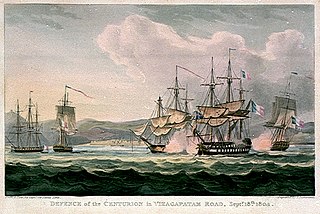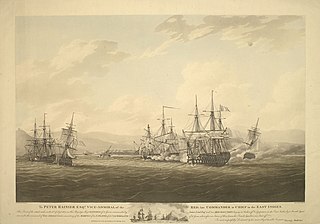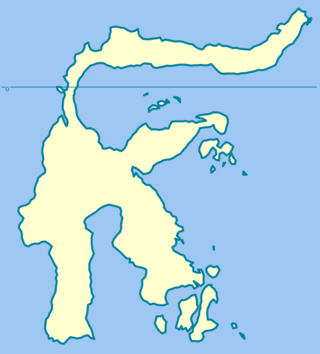
The Battle of Pulo Aura was a minor naval engagement of the Napoleonic Wars, fought on 14 February 1804, in which a large convoy of Honourable East India Company (HEIC) East Indiamen, well-armed merchant ships, intimidated, drove off and chased away a powerful French naval squadron. Although the French force was much stronger than the British convoy, Commodore Nathaniel Dance's aggressive tactics persuaded Contre-Admiral Charles-Alexandre Durand Linois to retire after only a brief exchange of shot. Dance then chased the French warships until his convoy was out of danger, whereupon he resumed his passage toward British India. Linois later claimed that the unescorted British merchant fleet was defended by eight ships of the line, a claim criticised by contemporary officers and later historians.

Charles-Alexandre Léon Durand, comte de Linois was a French Navy officer and colonial administrator who served in the American Revolutionary War and the French Revolutionary and Napoleonic Wars. He commanded the combined Franco-Spanish fleet during the Algeciras campaign in 1801, winning the First Battle of Algeciras before losing the Second Battle of Algeciras.

HMS Powerful was a 74-gun third rate ship of the line of the Royal Navy. She took part in the defeat of a Dutch fleet in the Battle of Camperdown in 1797, the capture of a French privateer in the action of 9 July 1806, in operations against the Dutch in the East Indies during the raids on Batavia and Griessie in 1806 and 1807, and finally in the Walcheren Campaign during 1809.

Sémillante was a 32-gun frigate of the French Navy and the lead ship of her class. She was involved in a number of multi-vessel actions against the Royal Navy, particularly in the Indian Ocean. She captured a number of East Indiamen before she became so damaged that the French disarmed her and turned her into a merchant vessel. The British captured her and broke her up in 1809.

The Atlantic campaign of 1806 was one of the most important and complex naval campaigns of the post-Trafalgar Napoleonic Wars. Seeking to take advantage of the withdrawal of British forces from the Atlantic in the aftermath of the Battle of Trafalgar, Emperor Napoleon ordered two battle squadrons to sea from the fleet stationed at Brest, during December 1805. Escaping deep into the Atlantic, these squadrons succeeded in disrupting British convoys, evading pursuit by British battle squadrons and reinforcing the French garrison at Santo Domingo. The period of French success was brief: on 6 February 1806 one of the squadrons, under Vice-Admiral Corentin Urbain Leissègues, was intercepted by a British squadron at the Battle of San Domingo and destroyed, losing all five of its ships of the line.

Linois's expedition to the Indian Ocean was a commerce-raiding operation launched by the French Navy during the Napoleonic Wars. Contre-Admiral Charles-Alexandre Durand Linois was ordered to the Indian Ocean in his flagship Marengo in March 1803 accompanied by a squadron of three frigates, shortly before the end of the Peace of Amiens. When war between Britain and France broke out in September 1803, Marengo was at Pondicherry with the frigates, but escaped a British squadron sent to intercept it and reached Isle de France. The large distances between naval bases in the Indian Ocean and the limited resources available to the British commanders in the region made it difficult to concentrate sufficient forces to combat a squadron of this size, and Linois was subsequently able to sustain his campaign for three years. From Isle de France, Linois and his frigates began a series of attacks on British commerce across the Eastern Indian Ocean, specifically targeting the large convoys of East Indiamen that were vital to the maintenance of trade within the British Empire and to the British economy. Although he had a number of successes against individual merchant ships and the small British trading post of Bencoolen, the first military test of Linois squadron came at the Battle of Pulo Aura on 15 February 1804. Linois attacked the undefended British China Fleet, consisting of 16 valuable East Indiamen and 14 other vessels, but failed to press his military superiority and withdrew without capturing a single ship.

The Battle of Vizagapatam was a minor naval engagement fought in the approaches to Vizagapatam harbour in the Coastal Andhra region of British India on the Bay of Bengal on 15 September 1804 during the Napoleonic Wars. A French squadron under Contre-Admiral Charles-Alexandre Léon Durand Linois in the ship of the line Marengo attacked the British Royal Navy fourth rate ship HMS Centurion and two East Indiaman merchant ships anchored in the harbour roads. Linois was engaged in an extended raiding campaign, which had already involved operations in the South China Sea, in the Mozambique Channel, off Ceylon and along the Indian coast of the Bay of Bengal. The French squadron had fought one notable engagement, at the Battle of Pulo Aura on 15 February 1804, in which Linois had attacked the Honourable East India Company's (HEIC) China Fleet, a large convoy of well-armed merchant ships carrying cargo worth £8 million. Linois failed to press the attack and withdrew with the convoy at his mercy, invoking the anger of Napoleon when the news reached France.

The action of 13 March 1806 was a naval engagement of the Napoleonic Wars, fought when a British and a French squadron met unexpectedly in the mid-Atlantic. Neither force was aware of the presence of the other prior to the encounter and were participating in separate campaigns. The British squadron consisted of seven ships of the line accompanied by associated frigates, led by Rear-Admiral Sir John Borlase Warren, were tasked with hunting down and destroying the French squadron of Contre-Admiral Jean-Baptiste Willaumez, which had departed Brest for raiding operations in the South Atlantic in December 1805, at the start of the Atlantic campaign of 1806. The French force consisted of one ship of the line and one frigate, all that remained of Contre-Admiral Charles-Alexandre Durand Linois' squadron that had sailed for the Indian Ocean in March 1803 during the Peace of Amiens. Linois raided British shipping lanes and harbours across the region, achieving limited success against undefended merchant ships but repeatedly withdrawing in the face of determined opposition, most notably at the Battle of Pulo Aura in February 1804. With his stores almost exhausted and the French ports east of the Cape of Good Hope that could have offered him replenishment eliminated, Linois decided to return to France in January 1806, and by March was inadvertently sailing across the cruising ground of Warren's squadron.

HMS Centurion was a 50-gun Salisbury-class fourth rate of the Royal Navy. She served during the American War of Independence, and during the French Revolutionary and Napoleonic Wars.

The Atlantic campaign of 1806 was a complicated series of manoeuvres and counter-manoeuvres conducted by squadrons of the French Navy and the British Royal Navy across the Atlantic Ocean during the spring and summer of 1806, as part of the Napoleonic Wars. The campaign followed directly from the Trafalgar campaign of the year before, in which the French Mediterranean fleet had crossed the Atlantic, returned to Europe and joined with the Spanish fleet. On 21 October 1805, this combined force was destroyed by a British fleet under Lord Nelson at the Battle of Trafalgar, although the campaign did not end until the Battle of Cape Ortegal on 4 November 1805. Believing that the French Navy would not be capable of organised resistance at sea during the winter, the First Lord of the Admiralty Lord Barham withdrew the British blockade squadrons to harbour. Barham had miscalculated – the French Atlantic fleet, based at Brest, had not been involved in the Trafalgar campaign and was therefore at full strength. Taking advantage of the reduction in the British forces off the port, Napoleon ordered two heavy squadrons to sea, under instructions to raid British trade routes while avoiding contact with equivalent Royal Navy forces.
Admiral Sir Lawrence William Halsted GCB was an officer of the Royal Navy who served during the American War of Independence and the French Revolutionary and Napoleonic Wars.

The action of 18 October 1806 was a minor naval engagement during the Napoleonic Wars, fought between the British Royal Navy frigate HMS Caroline and a Dutch squadron at the entrance to Batavia harbour on Java in the Dutch East Indies. During the battle the Dutch frigate Maria Riggersbergen was left unsupported by the remainder of the squadron and, isolated, was forced to surrender. Captain Peter Rainier, the British commander, was subsequently free to remove his prize from within sight of the Dutch port when the remainder of the Dutch squadron refused to engage Caroline and their crews deliberately grounded the ships to avoid capture. He also returned many prisoners taken previously in a captured brig.

The action of 26 July 1806 was a minor naval engagement of the Napoleonic Wars fought off the southern coast of the island of Celebes in the Dutch East Indies. During the battle, a small British squadron attacked and defeated a Dutch force defending a valuable convoy, which was also captured. The British force—consisting of the frigate HMS Greyhound and brig-sloop HMS Harrier under the command of Captain Edward Elphinstone—was initially wary of the Dutch, mistaking the Dutch East Indiaman merchant ship Victoria for a ship of the line. Closer observation revealed the identity of the Dutch vessels the following day and Elphinstone led his frigate against the leading Dutch warship Pallas while Harrier engaged the merchant vessels and forced them to surrender. Only the corvette William escaped, taking no part in the engagement.

The Java campaign of 1806–1807 was a minor campaign during the Napoleonic Wars by British Royal Navy forces against a naval squadron of the Kingdom of Holland, a client state of the French Empire, based on the island of Java in the Dutch East Indies. Seeking to eliminate any threat to valuable British merchant convoys passing through the Malacca Straits, Rear-Admiral Sir Edward Pellew determined in early 1806 that the Dutch naval forces based at Java, which included several ships of the line and three frigates, had to be defeated to ensure British dominance in the region. Lacking the forces to effect an invasion of the Dutch colony, Pellew instead sought to isolate and blockade the Dutch squadron based at Batavia in preparation for raids specifically targeting the Dutch ships with his main force.
The Raid on Griessie was a British attack on the Dutch port of Griessie on Java in the Dutch East Indies in December 1807 during the Napoleonic Wars. The raid was the final action in a series of engagements fought by the British squadron based in the Indian Ocean against the Dutch naval forces in Java. It completed the destruction of the Dutch squadron with the scuttling of three ships of the line, the last Dutch warships in the region. The British squadron—under the command of Rear-Admiral Sir Edward Pellew—sought to eliminate the Dutch to safeguard the trade route with China, which ran through the Straits of Malacca and were in the range of Dutch raiders operating from the principal Javan port of Batavia. In mid-1806, British frigates reconnoitred Javan waters and captured two Dutch frigates, encouraging Pellew to lead a major attack on Batavia that destroyed the last Dutch frigate and several smaller warships. Before the Batavia raid, Dutch Rear-Admiral Hartsinck had ordered his ships of the line to sail eastwards, where they took shelter at Griessie, near Sourabaya.
HMS Admiral Rainier was a Dutch 16-gun brig that the British captured on 23 August 1800 at Kuyper's Island, Java. They took her into service and named her after Admiral Peter Rainier, the leader of the British expedition. After the British sold her in 1803 apparently the French captured her in 1804 and sold her to the Dutch colonial government in Batavia for anti-piracy patrol. Her Javanese crew mutinied in 1806 and eventually sailed to Penang where vessels of the British East India Company (EIC) seized the vessel. She returned to British service, only to be captured and recaptured by vessels of the EIC. Her ultimate fate is unknown.
The Dutch corvette Scipio was launched in 1784. She convoyed Dutch East Indiamen between the Cape of Good Hope and Europe until HMS Psyche captured her at Samarang in 1807. The British Royal Navy initially referred to her as HMS Scipio, but then renamed her to HMS Samarang in 1808. She was not commissioned in the Royal Navy. She was instrumental in the capture of Amboyna and especially Pulo Ay, and participated in the invasion of Java (1811). She was sold at Bombay in 1814. She then entered mercantile service, sailing between Liverpool and India until 1827. She became an opium trader sailing between India and Canton, and was broken up near Hong Kong in August 1833.

HMS Caroline was a 36-gun fifth-rate Phoebe-class frigate of the Royal Navy. She was designed by Sir John Henslow and launched in 1795 at Rotherhithe by John Randall. Caroline was a lengthened copy of HMS Inconstant with improved speed but more instability. The frigate was commissioned in July 1795 under Captain William Luke to serve in the North Sea Fleet of Admiral Adam Duncan. Caroline spent less than a year in the North Sea before being transferred to the Lisbon Station. Here she was tasked to hunt down or interdict French shipping while protecting British merchant ships, with service taking her from off Lisbon to Cadiz and into the Mediterranean Sea. In 1799 the ship assisted in the tracking of the French fleet of Admiral Étienne Eustache Bruix, and in 1800 she participated in the blockade of Cadiz.

Captain Peter Rainier was a Royal Navy officer of the eighteenth and nineteenth centuries. Due to the patronage of his uncle, Vice-Admiral Peter Rainier, he was promoted quickly through the ranks so that by the age of twenty he was already a captain. He was given command of the 36-gun frigate HMS Caroline and on 18 October 1806 he fought a successful action in her against the Dutch 36-gun frigate Maria Reijersbergen at Batavia.
Rear-Admiral Sir John Marshall was a Royal Navy officer. Having joined the navy in 1800, he fought at the Raid on Batavia as a lieutenant in 1806 and was promoted to commander in 1812 while serving at the Siege of Riga. He was given a command on the East Indies Station and took passage there on HMS Java. Java was captured by USS Constitution in December and Marshall was unable to assume command. Subsequently released in a prisoner exchange, he was instead given command of HMS Shamrock in 1813. In December he was given command of a squadron of gunboats in the North Sea to assist in the attack and capture of Glückstadt, which was completed on 5 January.













